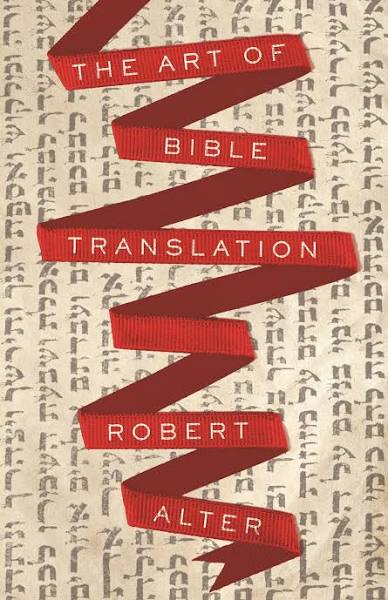I nearly wept with frustration over a biblical translation for Hebrew class in seminary fifteen years ago. The sentence was about God’s nose, and I was certain God’s nose wasn’t mentioned anywhere in the Bible. I finally remembered (or looked up) that the word could be also translated as anger and the verse clicked into place. I fell madly in love with Hebrew, a love I’ve neglected in parish ministry but which Robert Alter’s The Art of Bible Translation inflamed.
Alter, a literary critic and translator, has translated books of the Old Testament over the years and in 2018 published a translation of the entire Hebrew Bible. This slim volume decodes his translations, with chapters on syntax, word choice, sound and wordplay, rhythm, and dialogue. Sound esoteric? Perhaps. But as a former English major and Hebrew nerd, I loved it, reveling in references to John Updike and Ernest Hemingway mixed with Tyndale. Alter simultaneously praises the King James translation while pointing out significant issues such as the changes in English in the past four hundred years as well as the “rather imperfect grasp of biblical Hebrew” of its seventeenth-century translators.
Especially absorbing was reading about some of my favorite passages, such as Genesis 22 (the Binding of Isaac), which I translated (poorly) in seminary. Alter’s chapter on syntax captures the power of the pericope while painstakingly translating “take, pray, your son, your only one, whom you love, Isaac.” He refers to ancient commentator Rashi’s astute observation that “The sequence of God’s words…points to an undercurrent of tension in God’s obedient servant” (39), and shares Rashi’s imagined argument between God and Abraham. Indeed, Alter’s literary notes in the syntax chapter can blow open any Bible study. Take this, for example: “Characters’ first words are used to lay out the characterization of that figure” (43). That sentence will send former literature students back to Shakespeare class, remembering that the opening line and even opening word in Shakespeare’s plays were pregnant with meaning.
The chapter on word choice will aid sermon preparation, Bible studies, and any theological discussion. Consider the Hebrew word nefesh, for example, frequently translated as “soul” rather than as the more accurate physical meanings such as breath, throat, or neck. Or the word ravid being translated as “chain” when depicting the golden item Joseph wore around his neck when serving as viceroy to Pharaoh. Alter makes a convincing case for “collar.” Perhaps most astonishing is the verb used for Hagar “laying,” “putting” or “abandoning” Ishmael under a bush before positioning herself at a distance so she will not have to see him die. Alter asserts that the Hebrew word means only one thing: “fling.” Other translators, according to Alter, are reluctant to convey this meaning; ‘The startling effect of this moment is blunted by the translators’ choice of these verbs that in effect bowdlerize it” (50).
Puns and other wordplay are notoriously difficult to translate well or smoothly. Alter opens this chapter with an example of a pun in a John Donne poem before turning to Hebrew. “It seems to me better to try for equivalences than to give readers the misleading impression that the Hebrew has a single flat meaning,” Alter writes, before describing how richly puns and wordplay permeate the book of Job. This chapter gives readers a taste of Alter’s painstaking work to approximate some of the poetic puns in various psalms and prophetic books.
Rhythm is another tough area to translate and Alter asserts that the King James translation does a decent, if inconsistent, job of maintaining the rhythmic integrity of the Hebrew. Alter uses his literary background to help readers understand what he means by imagining an overzealous copyeditor messing with Moby Dick—e.g., what if, instead of leaving Melville’s words that the whale “has no face,” the editor replaced “face” with “countenance”; or, what if the end of chapter twenty-seven was changed from “called a coward here, hailed a hero there,” to “stigmatized as a coward here, celebrated as a hero there.” Such changes mess with the rhythm in ways that Alter recognizes in most modern English translations of the Bible. Alter holds up the parable of the ewe lamb told by Nathan to David as an example, noting that it is “set off lexically from the larger narrative, but this distinctiveness can scarcely be intimated in translation” (86). Even the well-loved Twenty-third Psalm is impossible to convey in its true compact rhythm, given that what takes five words to express in English—“The Lord is my shepherd”—takes only two in Hebrew.
Alter closes with a discussion of dialogue, asserting that “dialogue is the vital center of biblical narrative” (103), and he makes a case that English translations have not paid attention to the subtleties of dialogue, with extensive examples from Sarah, Joseph, and Jephthah. Sometimes Alter’s criticisms of other translations are almost catty, such as when being baffled by translations referring to menstruation, or comments such as this: “The translators are probably remembering the Shakespeare they read in high school” (120).
Alter’s translations are definitely worth using for sermon preparation and Bible study, and this companion volume to his translation will make reading those translations a richer experience.
Elizabeth Felicetti is the book reviews editor for Episcopal Café.
Robert Alter



